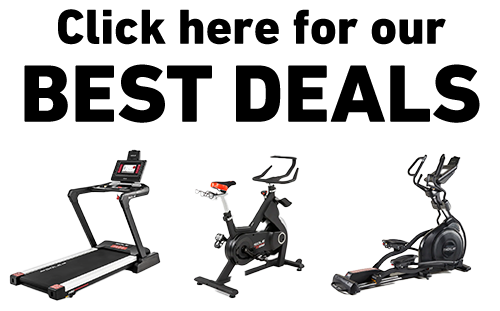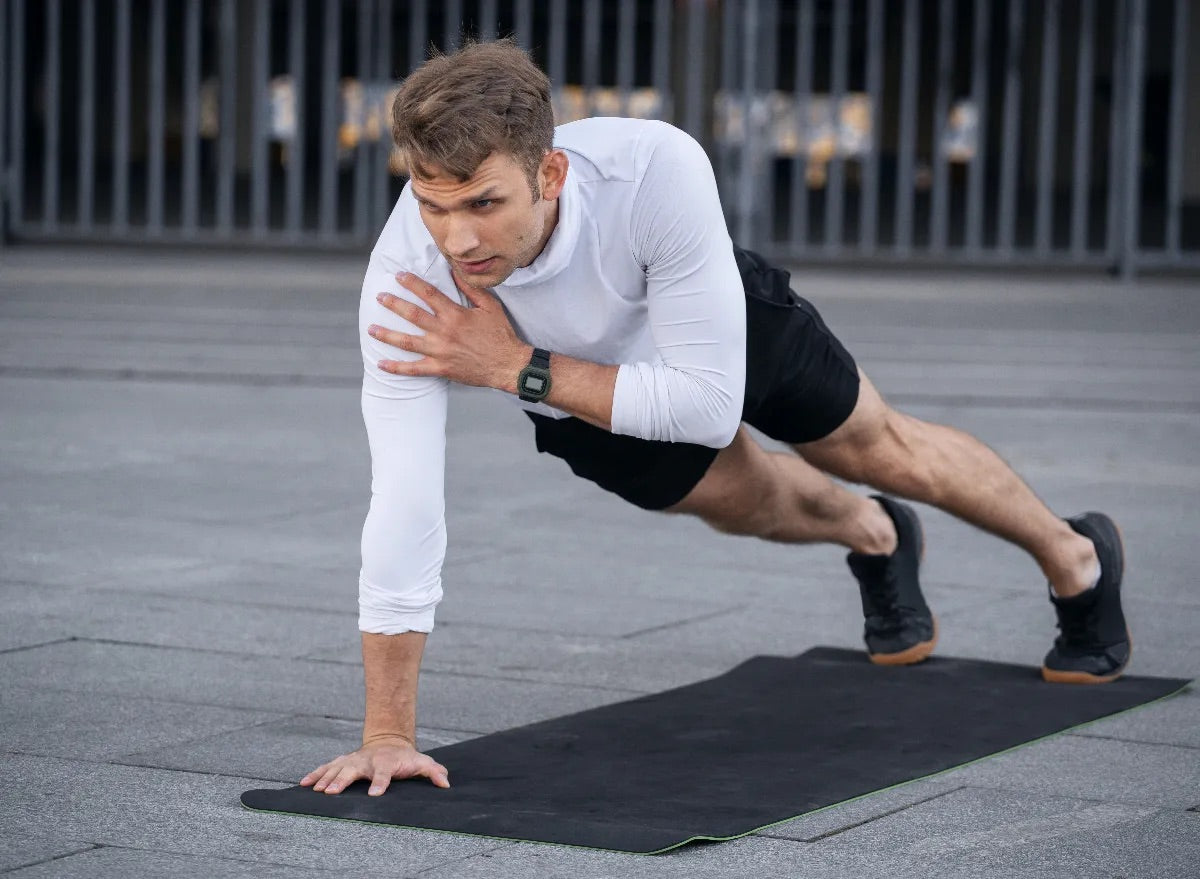Key Takeaways
- Tabata is actually a specific form of HIIT with strictly defined intervals of 20 seconds of maximum effort followed by 10 seconds of rest, repeated for 4 minutes.
- HIIT workouts are more flexible in their interval timing, typically featuring longer recovery periods and more customizable formats than Tabata.
- Both workout styles provide exceptional calorie burn during and after exercise through the afterburn effect (EPOC).
- SOLE Fitness precision-engineered treadmills and bikes provide exact speed and resistance control essential for Tabata workouts, while our free SOLE+ app features expertly programmed Tabata and HIIT classes that maximize both approaches for unparalleled home training results.
The Real Difference Between Tabata and HIIT
The fundamental distinction between Tabata and HIIT lies in their structure, intensity level, and origin. While Tabata follows a precise formula developed through scientific research, HIIT encompasses a broader category of interval-based training methods.
Understanding these differences is crucial for implementing either protocol effectively in your fitness routine.
Tabata: The 4-Minute Powerhouse Protocol
Tabata training was developed by Japanese scientist Dr. Izumi Tabata in 1996 while working with the Japanese Olympic speed skating team. His research revealed that short bursts of extremely high-intensity exercise followed by brief rest periods produced remarkable improvements in both aerobic and anaerobic fitness.
The classic Tabata protocol consists of 8 rounds of 20 seconds of all-out maximum effort followed by just 10 seconds of rest, totaling 4 minutes.
What many people don't realize is that true Tabata requires working at approximately 170% of your VO2 max, an intensity level so demanding that participants in the original study were often physically unable to continue after the 4-minute session.
HIIT: Flexible Intensity for Maximum Results
High-Intensity Interval Training (HIIT) is a broader concept that includes any workout alternating between intense activity bursts and lower-intensity recovery periods.
Unlike Tabata's rigid structure, HIIT workouts can vary significantly in their work-to-rest ratios, overall duration, and exercise selection. A typical HIIT session might involve 30–60 seconds of high-intensity exercise followed by 15–60 seconds of recovery, repeated for 15–30 minutes.
This flexibility makes HIIT more adaptable to different fitness levels, goals, and preferences, allowing for progressive intensity adjustments as your fitness improves.
Time Structures: Why They Matter
The dramatic difference in time structure between these protocols significantly impacts their physiological effects and practical applications.
Tabata's 2:1 work-to-rest ratio creates extreme metabolic stress in a compressed timeframe, making it ideal for time-efficient training but potentially too intense for beginners or those with certain health conditions.
HIIT's more balanced intervals and longer duration provide a challenging but more sustainable approach for most fitness enthusiasts, allowing for better technique maintenance throughout the workout while still delivering impressive cardiovascular and metabolic benefits.
|
Premium Home Gym Equipment with Award-Winning Quality!
Why Choose SOLE: ✓ Commercial-grade quality for home use 30-Day Money-Back Guarantee: Love it or return it, no questions asked. |
Calories Burned: Which Workout Torches More Fat?
Tabata's Calorie-Burning Potential
Due to its extreme intensity, Tabata training can burn approximately 13–15 calories per minute during the actual workout. While this might not sound impressive at first glance, Tabata workouts push your body to near-maximal exertion levels that few other workout styles can match.
This means that a properly executed 4-minute Tabata session can burn between 54–60 calories during the workout itself—impressive considering the ultra-short duration.
The real magic of Tabata happens after the workout ends.
Because Tabata pushes your anaerobic system to its limits, your body must work significantly harder to return to homeostasis, continuing to burn calories at an elevated rate for up to 24–48 hours post-workout.
HIIT's Energy Expenditure Benefits
Traditional HIIT workouts typically burn between 10–15 calories per minute during exercise, depending on your body weight, fitness level, and the specific exercises performed.
With sessions lasting 15–30 minutes, a complete HIIT workout might burn approximately 150–450 calories during the actual training period. The longer duration compared to Tabata allows for a higher total calorie burn during the workout itself.
HIIT also creates a substantial afterburn effect, though typically not quite as intense as Tabata due to the somewhat lower exercise intensity.
Additionally, because HIIT sessions are longer, the total afterburn effect plus caloric impact can be comparable or even greater than Tabata for many individuals.
The Afterburn Effect Explained
Both Tabata and HIIT create substantial post-exercise oxygen consumption (EPOC), commonly called the "afterburn effect." This physiological process forces your body to consume additional oxygen and burn extra calories for hours or even days after your workout ends.
EPOC occurs because high-intensity exercise creates metabolic disturbances that require energy to resolve: replenishing oxygen stores, clearing lactate, restoring hormone levels, repairing muscle tissue, and replenishing cellular energy stores.
5 Key Benefits Both Workouts Share
1. Time Efficiency
Perhaps the most celebrated benefit of both Tabata and HIIT is their remarkable time efficiency. In our busy modern lives, finding hours for exercise can be challenging, but these protocols deliver exceptional results in minimal time.
Tabata's 4-minute protocol represents the ultimate in exercise efficiency, while even longer HIIT sessions typically require no more than 20–30 minutes.
2. No Equipment Needed
Bodyweight exercises like burpees, mountain climbers, squat jumps, and high knees form the foundation of many effective high-intensity protocols.
This equipment-free approach removes barriers to consistent exercise and allows you to maintain your routine while traveling or when gym access isn't available.
3. Improved VO2 Max
VO2 max, your body's maximum rate of oxygen consumption during intense exercise, is one of the most important markers of cardiovascular fitness and a powerful predictor of longevity.
Both Tabata and HIIT are scientifically proven to significantly improve this key health metric. Dr. Izumi Tabata found that the tabata protocol improved subjects' VO2 max by approximately 14% in just six weeks, a remarkable improvement compared to traditional endurance training.
4. Enhanced Metabolic Rate
Both protocols trigger significant metabolic adaptations that extend far beyond the workout itself. Regular high-intensity training increases mitochondrial density and function, essentially upgrading your cellular energy production capacity.
This enhanced cellular metabolism contributes to improved insulin sensitivity, better glucose management, and more efficient fat utilization.
5. Adaptable for All Fitness Levels
Despite their high-intensity nature, both Tabata and HIIT can be modified to accommodate virtually any fitness level. The key is understanding that "high intensity" is relative to your personal capacity.
For a beginner, high intensity might mean brisk walking intervals, while for an advanced athlete, it might involve explosive plyometric movements. This scalability makes both protocols sustainable long-term training strategies that can evolve as your fitness improves.
Comparison Table: Which Workout Is Right For You
|
Feature |
Tabata |
HIIT |
|
Origin |
Developed by Dr. Izumi Tabata in 1996 |
Broad category of interval training |
|
Structure |
8 rounds of 20 seconds max effort, 10 seconds rest |
Variable intervals: 30–60 seconds work, 15–60 seconds rest |
|
Intensity Level |
Extremely high (~170% VO₂ max) |
High intensity (varies by individual) |
|
Work-to-Rest Ratio |
2:1 (20 sec work : 10 sec rest) |
Varies, commonly 1:1 to 2:1 |
|
Session Duration |
4 minutes total |
Typically 15–30 minutes |
|
Calorie Burn (During Workout) |
~54–60 calories burned |
~150–450 calories burned |
|
Afterburn Effect (EPOC) |
Very intense; elevated calorie burn up to 24–48 hours post-workout |
Substantial but usually less intense than Tabata |
|
Adaptability |
Less adaptable; requires high fitness level |
Highly adaptable to fitness level and goals |
|
Ideal For |
Highly time-efficient, anaerobic and aerobic improvements |
Versatile; suitable for most fitness levels |
|
Practical Considerations |
Very demanding; may be too intense for beginners or certain health conditions |
More sustainable over longer durations, allows better form |
Boost Your High-Intensity Training With SOLE Fitness
At SOLE Fitness, our equipment provides the precision control and instant feedback essential for optimizing high intensity interval training protocols. Our treadmills, bikes and ellipticals, offer exact speed adjustments and quick-touch controls that allow you to hit target intensities immediately—something impossible to achieve with outdoor running or basic equipment.
Plus, our 30-day trial guarantee lets you experience how professional-grade equipment transforms interval training effectiveness risk-free.
Get the optimum HIIT workout with SOLE Fitness
No matter if you're drawn to Tabata's four-minute intensity challenge or HIIT's adaptable approach to high-intensity training, your results depend on having tools that match your ambition. Ready to find out how precision equipment transforms interval training from good to extraordinary?
Frequently Asked Questions
Can I do Tabata and HIIT workouts on the same day?
While technically possible, combining both protocols in a single session isn't recommended for most people due to the extreme cumulative fatigue. If you want to incorporate both, consider using traditional HIIT as your main workout (15–20 minutes) followed by a single 4-minute Tabata round as a finisher, but only if you're advanced and well-conditioned.
Which protocol burns more fat - Tabata or HIIT?
Both protocols are highly effective for fat loss, but through slightly different mechanisms. Tabata's extreme intensity creates a more dramatic afterburn effect, potentially burning calories at a higher rate for 24–48 hours post-workout. However, HIIT's longer duration typically results in more calories burned during the actual workout session.
What's the minimum fitness level needed to start HIIT or Tabata training?
HIIT can be safely modified for virtually any fitness level, including complete beginners. Start with simple exercises like marching in place or gentle bodyweight movements, using a 1:2 work-to-rest ratio (20 seconds work, 40 seconds rest) and building intensity gradually over several weeks. True Tabata protocol, however, requires a solid fitness foundation and should only be attempted by intermediate to advanced exercisers.
How does SOLE Fitness equipment enhance Tabata and HIIT training effectiveness?
SOLE Fitness equipment provides the precision control and instant feedback essential for optimizing interval training protocols. Our treadmills, bikes and ellipticals feature responsive resistance systems that enable seamless transitions between work and recovery phases.
Most importantly, our free SOLE+ app includes professionally designed HIIT classes specifically programmed for our equipment, with expert instructors who understand the precise timing, intensity, and progression. With SOLE, you’ll be training at the right intensity for maximum results.




Leave a comment
This site is protected by hCaptcha and the hCaptcha Privacy Policy and Terms of Service apply.